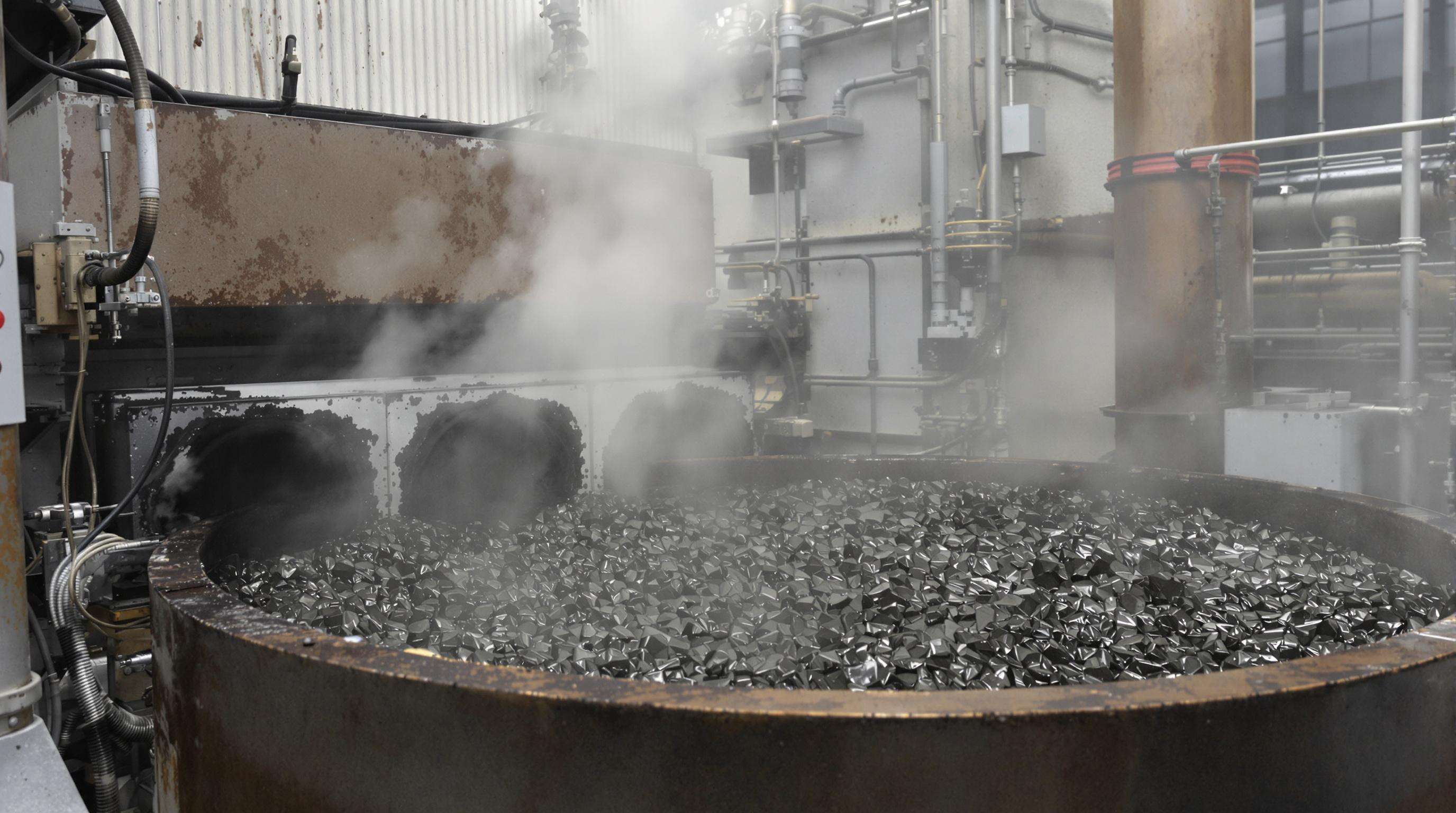Oil refineries and petrochemical facilities are producing about 35% more sludge compared to what they did ten years back according to IEA data from 2023. The main reasons behind this increase include processing heavier crude oils and dealing with older infrastructure that isn't as efficient anymore. What we're talking about here is basically thick sludge made up of various hydrocarbons mixed with water and solid particles. This stuff causes all sorts of problems for operations. Pipelines get clogged regularly, storage tanks fill up fast enough to take up between 12 and 18 percent of available space every year, and there's always the risk of fires breaking out because of it. Take one particular refinery located somewhere in the Midwest as an example. They ended up spending around four million dollars just last year fixing equipment that stopped working due to sludge buildup. These costs highlight why many plants are starting to invest in better treatment solutions such as cracking furnaces which can handle these waste materials more effectively.
Under the EPA's new 2024 Hazardous Waste Disposal Directive, companies must recover at least 90 percent of usable hydrocarbons from their sludge waste, which is a jump from the previous requirement of just 75 percent back in 2020. Facilities that fail to meet these standards risk getting hit with hefty penalties running as high as fifty thousand dollars for every ton of waste they leave untreated. These regulations actually fit right into the bigger picture of worldwide sustainability efforts aiming to cut down on industrial waste by nearly half before the end of this decade. For smaller and mid-sized businesses looking to stay compliant without breaking the bank, thermal conversion technologies such as cracking furnaces have become pretty much the only realistic option available today. Most plant managers I've spoken to agree that while expensive upfront, these systems ultimately save money in the long run when compared to traditional disposal methods.
Three refineries along the Gulf Coast faced a total of $2.7 million in fines back in 2023 because their sludge failed EPA toxicity tests. When auditors looked into what went wrong, they found that poor thermal treatment methods were responsible for making the sludge contain 22% more harmful substances called polycyclic aromatic hydrocarbons or PAHs than allowed by regulations. After getting hit with these penalties, each refinery installed new modular cracking furnaces across their operations. Within about half a year, the PAH levels dropped from 15 parts per million down to just 8 ppm. According to research from the Ponemon Institute released last year, this improvement saved companies around $740,000 annually in potential future violations while also helping protect local ecosystems from contaminated waste products.

Compact cracking furnaces are used to break down those complicated hydrocarbons found in oil sludge using what's called controlled thermal decomposition. When we expose this sludge material to carefully managed heat levels, the system actually vaporizes all those organic components while leaving behind the heavier stuff like metal residues. What makes these units really effective is their modular design approach. This means they can keep running efficiently even when dealing with different types of waste inputs that come in varying compositions day to day. For anyone working in waste management, this flexibility solves one of the biggest headaches they face regularly.
Endothermic cracking dominates the initial phase, decomposing long-chain hydrocarbons into lighter fractions. Simultaneous vapor reformation minimizes carbon buildup by converting residual tars into syngas (primarily Hâ and CO). This dual-phase mechanism achieves 10â15% higher energy recovery than conventional incineration, according to recent thermal treatment comparisons.
The EPAâs 2022 pilot trials demonstrated that compact cracking furnaces recover 85â92% of organic content from oil sludge, converting it into reusable fuels. This performance aligns with growing demands for waste-to-energy solutions in refineries facing tightening landfill restriction policies.

The sweet spot for cracking furnace efficiency lies somewhere between 450 and 650 degrees Celsius. This temperature window manages to break down most organic materials without wasting too much energy in the process. When the heat drops below 450C, we tend to see leftover hydrocarbons hanging around from incomplete reactions. On the flip side, pushing past 650C just burns through extra fuel and starts wearing out those expensive refractory linings faster than needed. According to some research published by the Department of Energy back in 2023, running these systems at about 550C cuts down on energy usage by nearly 18 percent over older pyrolysis techniques, all while still getting close to that magic 92% conversion rate.
Keeping materials in the reactor for around 8 to 12 minutes generally produces the best syngas quality since it gives enough time for those stubborn heavy hydrocarbons to break down completely. When the process runs too short, we end up with more tar forming in the system sometimes as much as 14% by weight which messes up everything downstream. On the flip side, running the cycle too long just burns through extra energy without much benefit. Some big players in the industry have run tests showing that after about 10 minutes in the reactor, they hit around 95% pure syngas. That's pretty much the magic number most facilities need to hit before their product will pass muster with industrial standards.
Maintaining an equivalence ratio (ER) of 0.25â0.35 ensures optimal oxygen availability for partial oxidation without triggering full combustion. This "oxygen-lean" environment maximizes liquid yields while minimizing COâ emissions. Process simulations reveal ER deviations 0.05 reduce bio-oil yields by up to 22% and increase particulate emissions by 30% (EPA process guidelines, 2022).
Operators must balance:
| Parameter | Energy Cost Impact | Yield Benefit |
|---|---|---|
| Temperature +50°C | +12% | +8% Conversion |
| Residence +2min | +9% | +5% Syngas Purity |
| ER Adjustment +0.1 | -6% (lower Oâ use) | -15% Liquid Yield |
The optimal configuration typically achieves 85â88% total energy efficiency while recovering 90%+ of recoverable hydrocarbonsâa benchmark verified across 47 operational units in 2023 field assessments.
Modern cracking furnace designs are unlocking new pathways to transform oil sludge into high-value products while meeting stringent environmental standards.
Adding catalysts to thermal cracking processes improves bio-oil quality significantly, mainly because it cuts down on both viscosity and sulfur levels. New developments in zeolite catalyst technology have boosted the production of usable hydrocarbons by around 18 to 23 percent when compared with standard thermal cracking methods without catalysts. Research on material conversion continues to back this approach, showing that catalytic treatment remains essential if we want to get products that refineries can actually work with instead of just raw bio-oil.
Syngas from oil sludge typically contains 12â15% particulate contaminants, requiring advanced purification for energy recovery. Third-generation ceramic membrane systems now achieve 99.2% filtration efficiency at 550°C, enabling direct syngas use in combined-cycle turbines. Field trials show these systems reduce cleanup costs by 40% compared to traditional scrubber units.
The solid residue from cracking furnaces demonstrates dual environmental benefits:
These value streams transform oil sludge from a liability into a circular economy asset.
The modular cracking furnace technology is changing how we handle oil sludge problems, allowing treatment right where it's produced instead of shipping everything away. According to industry insiders, these smaller mobile units cut down on transportation expenses by roughly 40 to 60 percent when compared with old school central processing methods. For those working on offshore rigs or out in the middle of nowhere at refineries, this makes a huge difference. These systems can tackle anywhere from 2 up to 5 tons of sludge every hour, all while taking up about a third less room than what traditional equipment needs. That kind of efficiency is why so many operators are making the switch nowadays.
Advancements in ceramic-matrix composites have extended cracking furnace operational lifespans by 200â300%. Modern refractory linings withstand temperatures exceeding 800°C while resisting corrosion from acidic sludge components. This durability improvement reduces maintenance downtime by 45â55%, according to 2023 metallurgical research.
A major Gulf of Mexico operator achieved 92% sludge-to-fuel conversion rates using modular cracking furnaces on production platforms. This implementation eliminated marine transport risks and reduced processing costs by $18/barrel compared to shore-based alternatives.
While compact cracking furnaces require 20â35% higher upfront costs than incineration systems, operators realize ROI within 18â30 months through avoided disposal fees. A 2024 economic model shows lifetime savings exceeding $2.8 million per unit when processing 50+ tons daily.
Modern cracking furnaces transform 85â90% of sludge mass into reusable hydrocarbons, cutting COâ emissions by 62â68% versus landfill disposal. This closed-loop approach supports circular economy goals while generating carbon credits worth $120â$150 per ton of treated sludge.
The primary causes include processing heavier crude oils and aging infrastructure that leads to inefficiencies and more sludge accumulation.
Improper handling can lead to fines, equipment damage, and ecological harm. Facilities face penalties up to $50,000 per ton for untreated waste.
They allow for on-site sludge treatment, reducing transportation costs by 40-60% and processing up to 5 tons per hour efficiently.
 Hot News
Hot News2024-09-25
2024-09-18
2024-09-12
2024-09-05
2024-08-30
2024-08-23

Copyright © 2025 by Shangqiu AOTEWEI environmental protection equipment Co.,LTD Privacy policy